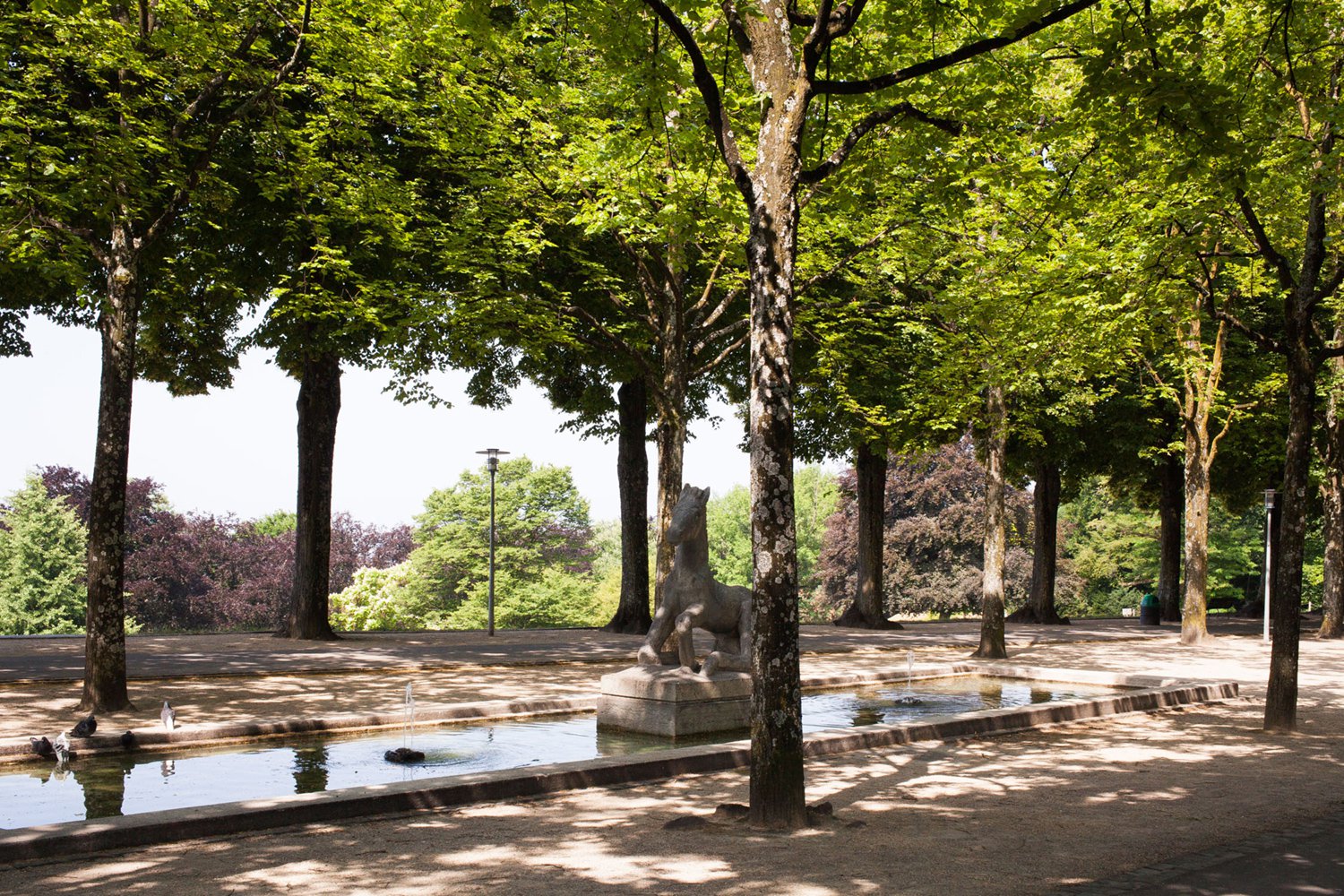
Our route begins in Parc Valency in a fragment of untouched countryside, the very countryside where Lausanne’s wealthy residents spent their summers until the turn of the 20th century. If this parcel of land has avoided the asphalt, it is thanks to a petition launched by local residents in 1906 who called for a little more space and greenery. The City purchased the site and turned it into a public park in the late 1930s. Soon thereafter, during World War II, the park was temporarily used for sustenance purposes after being transformed into a potato field (Wahlen plan).
Under our feet lies a rare piece of rolling open ground in the city. However, with its topography born out of multiple earthworks, there is not much that is “natural” about Valency’s soil and its structure. What might urban open ground look like? Such is the question addressed by L'Incise (1), which cuts through the slope to unveil its secrets, while a path leads us through the park’s invisible layers.
All around us, the tall trees are like flag-bearers for the open ground, which in turn gives them the necessary impetus and freedom to bloom. In Valency, they fly the col- ours of the precious subsoil. A little to the west of the park, Cambium (2) invites us into its intimacy. The installation offers a haven of cohabitation — like a decompression chamber — between two tall trees in Valency and the human beings who use this pocket of nature intensively.
A neighbourhood centre, where city-dwellers relax and meet, the park is always busy: darting dogs, sandy kids, laughing or dripping wet as they climb out of the local (and free!) swimming pool, seniors with their heads bobbing, hands behind their backs, walking to the pace of a passeggiata... In the middle of the central grove, you will sometimes come across the remains of a campsite. What urban spirit, what city nymph lives here? The same who put up the swings that sway a little higher up? Under the French-style line of lime trees, Bal-ysage (3) offers a mobile and playful perspective on the lake and the mountains.

We then leave the park on the north-eastern side. On the other side of the street, opposite the paediatric hospital, we see the first fresco, Place to live (4) and the young girl who will tend to the walls all along the route.
Walking up Chemin de Montétan, we enter a small park of the same name. Inaugurated in 1931, this park is an ancestor of Parc Valency in a way. The City bought back the paediatric hospital’s land following the petition of 1906. However, this was not enough to satisfy the Western residents’ hunger for greenery who found the park too small and soon re-entered the fray to request more space. Behind the neat and tidy archways of hornbeams lies a strange, unkempt area, where the grass is silently eating at the gravel, although it seems to have eaten a little too much this time. Micro Macro (5) invites us into another dimension, like miniature adventurers in a land of giants.
To return to our normal space-time and continue our route, we first have to exit the maze and take the dirt road that meanders behind the tall trees at the edge of the park. Might we have taken a wrong turn? It is something that happens quite frequently to space-time travellers after all. Did a signalling error lead us into this dense and mossy forest trail? It is only by pushing further on, behind the first bend that we return to Lausanne’s urban world. Although, walking along the backyards of the buildings on Avenue d’Echallens with their unlikely footbridges, old workshops and horse barn remains, we might wonder what century we have landed in, and the joyfully chaotic vegetation along the way does nothing to remind us of urban order...
Finally, we come out on the asphalt in Avenue Glayre and walk down towards the even more bituminous Avenue d’Echallens. We head due east.
Railway tracks, traffic, adjoining facades... On the north side of the street, a stocky former garage breaks with the physiognomy of the other buildings. Right after that, we enter an area of urban infill. The only undeveloped plot on this side of the road, this vacant interstice is more precious than it looks. We imagine a little greenery, a place to meet and watch life go by in the street, but it is parked cars that occupy the ground here. The only thing left is the retaining wall of Saint- Paul’s Church, one of the sturdiest in Lausanne, a survivor of the times when vineyards were cultivated on this slope. It is the only available space for a pioneering and vertical garden to conquer where Nature vivante (6) takes it over to reveal its hidden side: a moving image that depicts the transformation of the soil behind the stone.
Back on Avenue d’Echallens, we walk across the flow of traffic, along the southern pavement, to the place where the LEB (Lausanne-Echallens-Bercher) train dives into the bowels of the Earth. Just before, on the right, lies a slightly unreal bower-lined small square. The place is somewhat overly rigid to be sincerely green and yet it is this miniature grove (Forêt des Clochettes) which the local wildlife has decided to take over in Bestial ! (7). Maybe it is because this place, as artificial as it may be, nevertheless acts as a permanent refuge for biodiversity and an island that shelters and manufactures life in the middle of all this concrete. Something that is indeed noticeable in the absence of grass by the number of worm casts — small sculptures of worm excreta — that decorate the pseudo-undergrowth.
Earthworms are essential to the regeneration of the soil. Their galleries facilitate the flow of air and water. Thanks to their continuous comings and goings in the depths, they aerate the soil, mixing organic matter from the topsoil with mineral matter from the bedrock. This mineral-organic alliance contributes to the soil’s invaluable wealth, giving it all its properties, such as its structural stability and its capacity to retain water and nutrients. This is how earthworms have earned the title “soil engineers”, but we could also add architect, alchemist or occasional sculptor.
The route carries on east via the ramp that goes down to the right of Forêt des Clochettes and allows for better contemplation of its archaic and imaginary fauna.
We then walk back up Avenue d’Echallens, cross the street, and climb up the staircase that enables us for once to ac-cess the curious cantilevered balcony that overlooks the street. This is where the semi-public garden of the Asile des Aveugles (Asylum for the Blind) hides, created in 1843 and nowadays called Hospital Jules-Gonin. Here, during the lunch break, while watching the lake and the underground construction work for the LEB train, talk is about retinal detachment. Opposite, the ground is being dug up 42 metres below the surface to remove the excavation materials from the tunnel that will let the train through at the end of 2020.
Here and there, stumps appear like comfortable seats for the contemplative. A particularly large one from a tall beech tree that was felled in December 2014, remains. Rest in peace. Too old, frail and unstable, the old fellow suffered a split personality disorder at trunk level that was exacerbated by genetic issues. Do old trees in the city need palliative care or should they be replaced as soon as possible? Vanitas (8) pays tribute to these venerable old stumps and their role in biodiversity with a mausoleum for dead wood.
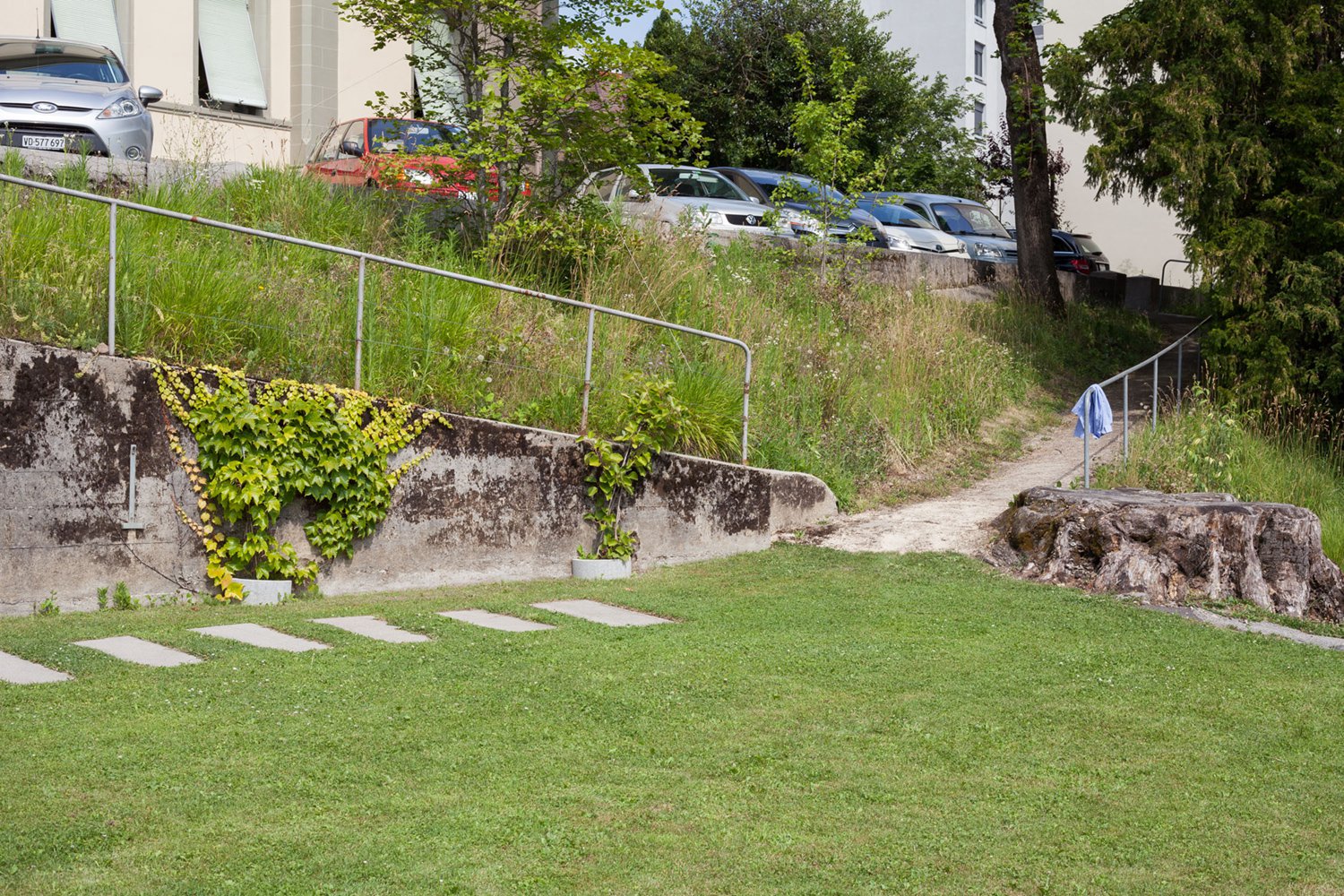
We then walk up the zigzagging path and out of the hospital courtyard, via the Banque des Yeux (Eye Bank). Avenue de France gently takes us back down towards Tour Galfetti and Place Chauderon. Outside the historic city walls, for a long time the area used to be home to vineyards and fields. Later, following the installation of a weighing station (to weigh animals), it became an important trading venue. From 1850, the square hosted a horse and hay market. There was also a cemetery there until the LEB station drove the dead out. Before the construction of the tower in 1992 and where it now stands, there was a cul-de-sac and a grain merchant nestled there. Today however, the place seems to have completely lost touch with its soil.
Typical of the Ticinese “tendenza” school, the design of the tower was dreamt up by architects Aurelio Galfetti and Mario Botta. The dark and unwelcoming circular court- yard, offers no other landscape than itself. Concrete, stone, glass, colonnades, guard rails, passageways. A spot of sky high up... At best, it is a place of passage, sometimes of traffic, even if a little animation unexpectedly emerges from the underground with the No Name/Chauderon 18 nightclub. A green cousin of the disco ball, Kokedamas (9) and its lush chandelier seek to soften the atmosphere of this mineral silo, to add a little greenery, earth and life in the harshness of a seemingly bygone era.
We then walk across the road towards the southern side of the square to the large administrative building that glimmers with all its vintage windows. At the end of the footbridge that leads up to it, the Vert de terre (10) slide invites us to slip into the role of an earthworm. Right next to it, 9m3 (11) and its young, potted plane tree address the restricted space we give trees in the city nowadays.
The route then doubles back down a floor, through an underground passage and across Place Chauderon. A colourful mosaic of strawberry plants, wild thyme, lily of the valley and other St John’s wort warm up the place a little, while the dark and geometric marble of the LEB station vaguely evokes the Galfetti tower. Looking down towards the escalator, we realise that although we are underground, the real soil is still far away. At the end of the tunnel, we return to the surface via the ramp on the right and come across the ancestor of the young plane tree in 9m3 (11): a hundred-year-old which has grown unhindered to become quite majestic.
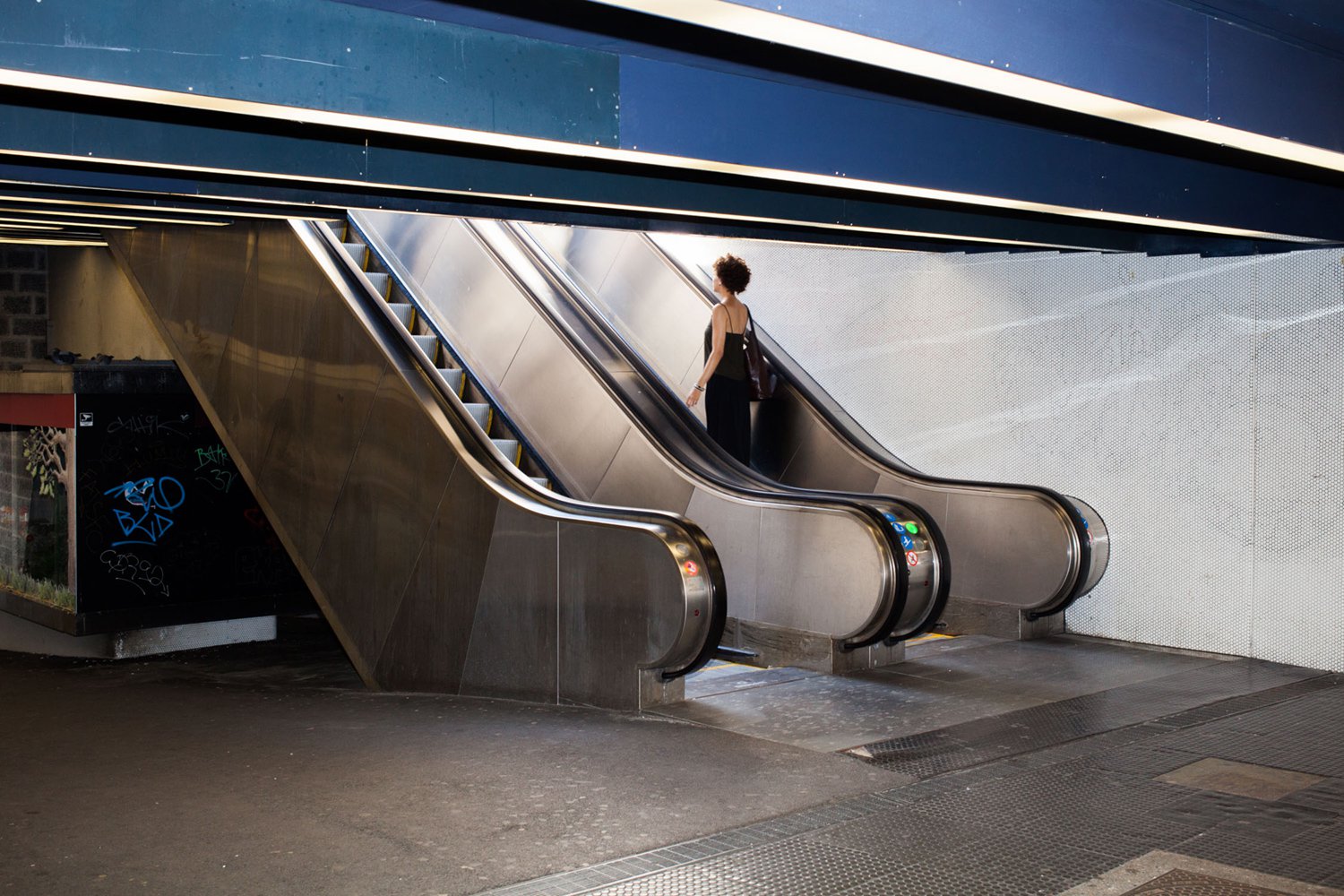
To penetrate into the Terreaux maze, we have to walk under the belly of the building opposite. It is a strange mixture of eras in this maze that leads to the Humus gallery. The word Terreaux (“compost”) comes from remblais (“backfill”), because we are here at the foot of the city’s former fortifications, lined with a ditch and a path. Over time, the area has filled up, shrunk and become tangled. Decades of action have created numerous layers. Overload is a plague that erodes the public domain and Terreau incognito (12), with its sudden burst of greenery, seeks to pacify this acute form of outdoor layout.
And — who knows? — it might bring a little freshness too, because the overabundance of concrete stores up the summer heat, while earth absorbs water like a sponge and releases it in the form of vapour against a little thermal energy. This exchange helps lower the temperature. Asphalt is not the only thing that retains the heat: buildings do too, leading to growing interest in vertical revegetation — as offered in Nature vivante (6) on the retaining wall of Saint- Paul. This solution is currently easier to apply than digging up the concrete to return to open ground.
The route continues through the passage north of the Terreaux Church, under the pink building. We turn right on Rue de l’Halle all the way to Rue Mauborget. From there, we walk straight down towards Bel-Air Tower, the first sky-scraper in Switzerland, inaugurated in 1932.
We then walk across the road onto Route de Bel-Air, which runs parallel to the archways of the Grand Pont on the southern side. On our left, the young girl in Place to live (4) has found a new interstitial plant to grow. On the right, the ghostly trees of Le Verger de la paix (13) hang on to the ventilation grids of the LEB and the seating places all around provide visitors with an opportunity for a well-deserved break.
From there, we get to admire the work that connects Bel-Air with Saint-François. Initially it was called Pont Pichard, after visionary Cantonal engineer Adrien Pichard, who in the mid-19th century endeavoured to ease the crossing of Lausanne. Opened to traffic in 1844, it stood 25 metres high, 175 metres in length, with 2 levels, and 19 superior and 6 inferior arches. Overlooking the Flon district, it spanned the industrious lower city, linking the wealthy families of the upper city. The lower level was buried in 1874 when the Flon was filled, bringing the height of the structure down to 13 metres.
The bridge is a sign of the victory of engineering over nature, of structured order over chaotic topography. The city has subdued its territory, forcing it to meet its needs — pass, walk across, trade — even if that has meant burying rivers and tarmacking the ground.
All this construction work has a cost, however. We deprive ourselves of the ground’s capacity, especially in terms of letting rainwater seep in and be absorbed, which greatly reduces the risk of flooding. The torrents that streamed down Rue Centrale, under the Grand Pont and elsewhere in Lausanne on 18 June 2018 illustrate the extent to which the city’s ground has become impermeable.
Regardless, the bridge has changed the structure of Vaud’s capital city, lying at the origin of the development of a key east-to-west axis outside the walls: the axis which our route follows. Still very much used today, the bridge should be closed to car traffic in favour of pedestrians, bikes and buses by 2022.
Soilless and suspended, can a garden find its place in the new urban order? Such is the fantasy addressed in Un Jardin sur un pont, un pont sur un jardin (14) with its optical illusions on the northern pavement of the Grand Pont. To see it close up, you have to climb the stairs or take the elevator up from Place de l’Europe, double back to the footbridge and walk across the road.
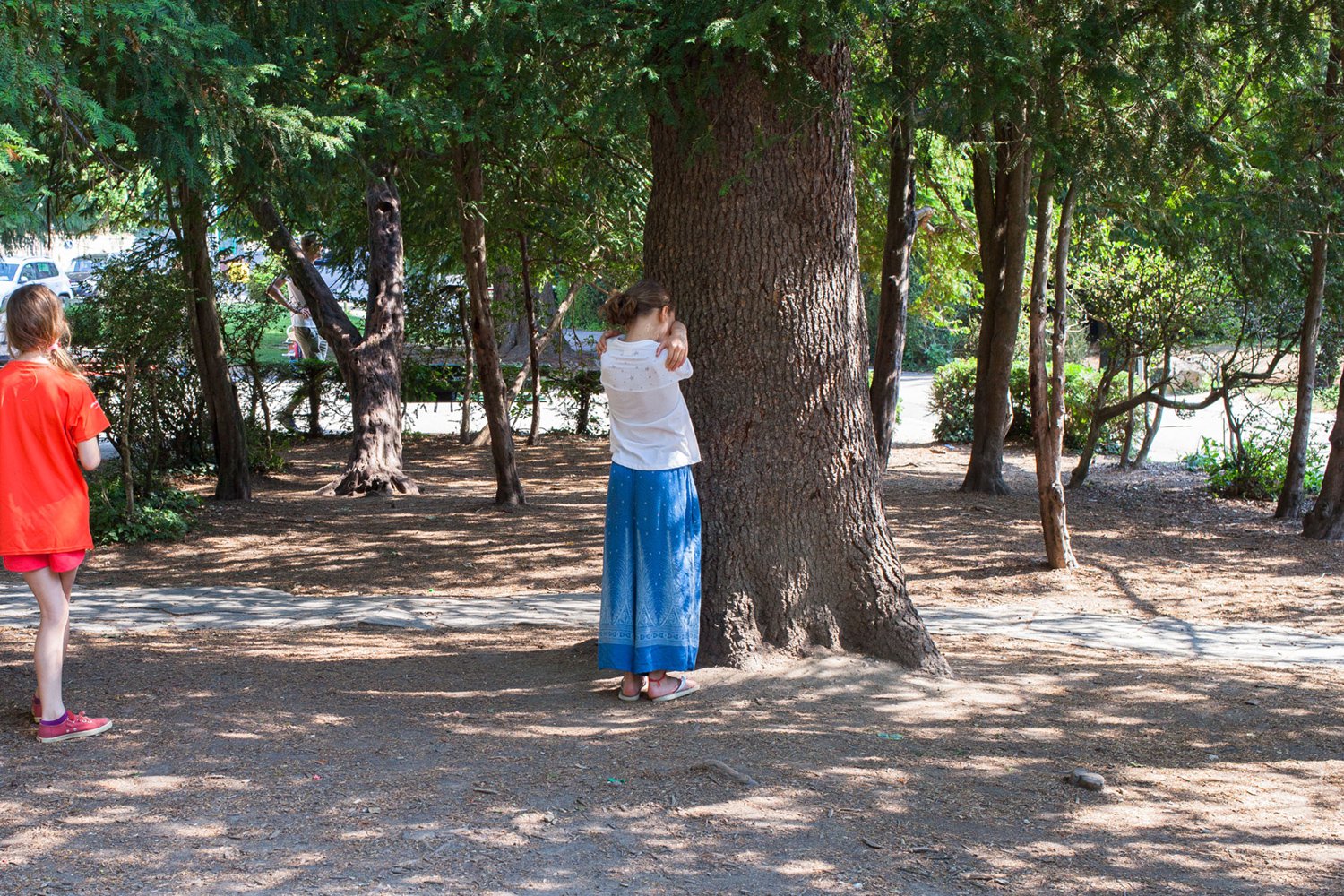
Once out of these imaginary vales, we continue towards Saint-François and the south side of the square, where the incongruous geyser of L’Eau et vous (15) reminds us of the presence of water in the underground.
The route then makes a start on Petit-Chêne before doubling back and diving into the western entrance to the Saint-François tunnel. As written on the pediment, the pas- sage was built in 1980 at the time when the north part of the square was turned into a pedestrian zone, and it looks a little as if it has remained stuck in time, as evidenced by the linoleum. Passage végétal (16) takes inspiration from horehound, a medicinal plant that grows naturally in Saint-François as well as in the display cases that overlook the tunnel for the occasion, transforming this unclaimed place into a pavilion to enjoy some coolness during the summer.
Walking back out the other side, we end up in front of Saint-François Church, built between 1270 and 1275 by Franciscan monks. Since then, it has been restored several times, notably after the great fire of 1368. For Lausanne Jardins, it has been turned into a workshop for the artistic bacteria of Futur Âge de pierre (17) which sculpt the ground.
Outside the church, we are struck by eight huge plane trees, as tall as the surrounding buildings. Thousands of square metres of leaves and bark make up a canopy of sorts, united and eternal, indifferent to pollution. On the ground, the feet of the trees are reduced to their minimum, trapped by cobblestones. What is happening underneath? The underground activity between trees of the same variety is well-known: pooling of resources, sharing immunity, solidarity. Complex flows pass from one to the other, often through the intermediary of mushrooms, sometimes through direct channels built by the trees themselves — an intense network, the visible tip of which only gives a simplified image.
However, this network has to compete with many others: water, electricity, communications... As night falls, Portrait d’un arbre (18) is projected like a ghost on the only place in the square that still holds enough space, albeit underground, to host a ninth plane tree.
We then walk towards the eastern tip of the square, before crossing over to the southern side again where Renaissance du peuplier (19) tells us how another tree found a new reason to live in its close vicinity.
The route continues on the same pavement towards Capitole, the largest cinema in Switzerland, opened in 1928 and which now hosts the Swiss Film Archive. Opposite, on the wall of Promenade Derrière-Bourg, the young girl from Place to live (4) has fallen for a new rebellious plant.
Just after the cinema, there was once a bit of countryside, which even boasted the status of primeval forest at some point. That was in the early 1970s, after the dem- olition of the villa of the De Jonghs, a family of photographers who owned the land for a long time. Dedicated to Jean Villard-Gilles at his death in 1982, the land became a public park two years earlier with the construction of a small amphitheatre at the top. This summer, the latter will host a one-off permanent performance of La Grande Pimprenelle (20), a floral comedy featuring 1200 loquacious stalks on stage.
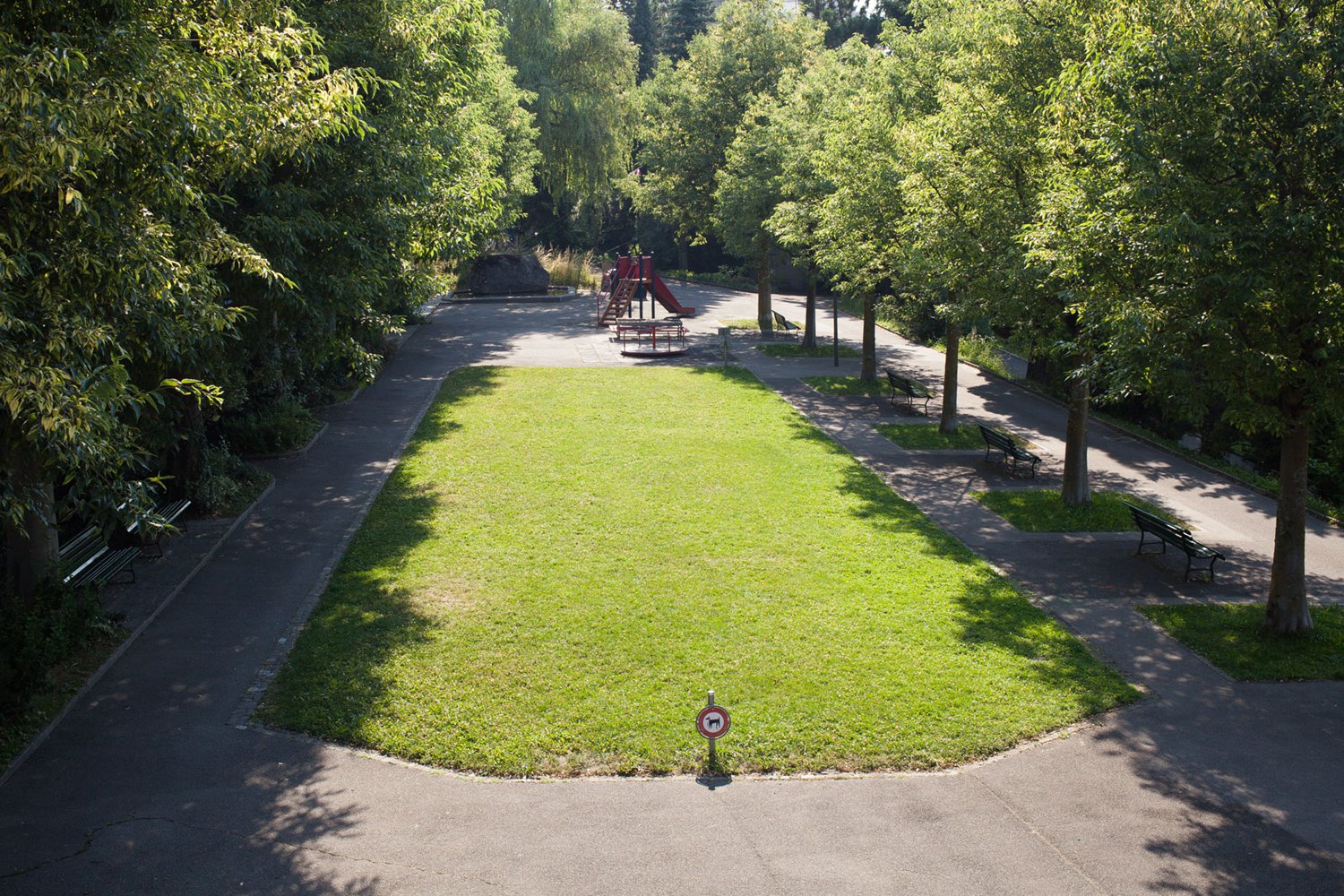
We then let ourselves drift along the route that meanders like the Venoge which the aforementioned poet adored, all the way to Rue du Midi before turning left into Avenue Georgette and up to the intersection of the same name. The name actually comes from “small gorge”, the last vestige of a time when a stream used to flow there.
For lack of water, we walk across the flow of traffic towards Avenue de Rumine, but not for long. With a bit of luck, after the first house, we will get a glimpse of Le Point (22 a), a first sign of the next site: a red sail flying in the air at regular intervals, to the rhythm of an underground vent. The site is a garden perched atop the roof of the Bellefontaine car park, but before getting there, you have to walk by the ticket machine where Racines (21 b) illustrates the vegetation’s difficulty in living so far away from the soil, with its roots that poke through the ceiling.
We then take the ramp up to the terrace where lies an almost forgotten garden which has fallen into a slumber since the 1960-70s like a fairy-tale princess, and which stu- dents from Hepia (Geneva School of Engineering, Architec- ture and Landscape) and ECAL (Lausanne University of Art and Design) have endeavoured to awaken. Inversion (21 a) offers a role-playing game where plants and humans trade roles, while Entrance (22 c) gives some unexpected depth to this potted garden. At night, The Nocturnal Garden (22 b) and its lights invent a new staging for the Bellefontaine terrace.
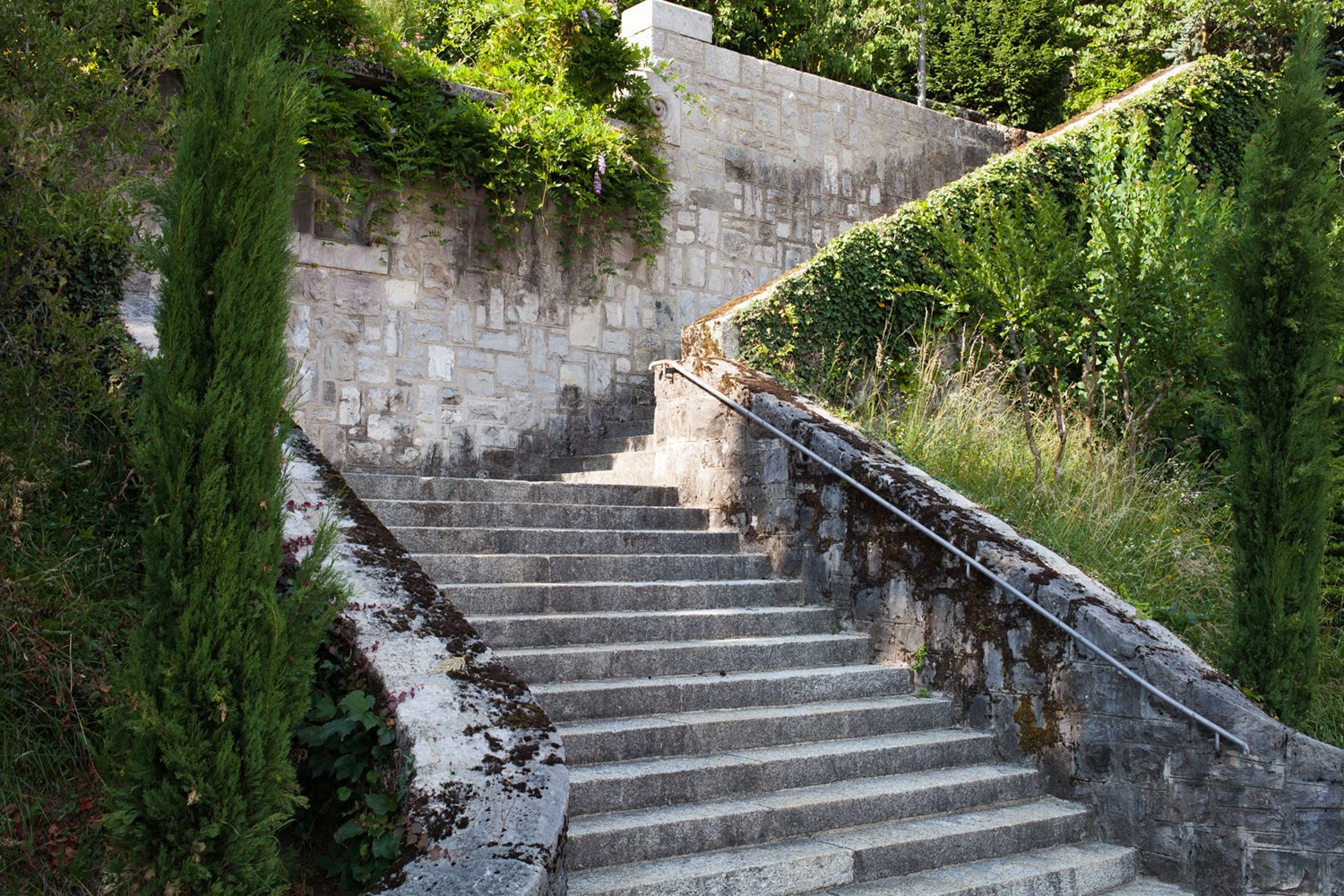
We walk back down on the east side of the car park and back up towards Avenue de Rumine, which we cross to follow the northern pavement and its front gardens. The English-style front lawns mark the end of the city centre and the beginning of the residential district, like a light version of the thuja barricade in Latin culture. No aperitives are drank there, no tomatoes cultivated, these simply play their role as buffers between public and private space, and the banality of these green patches is but an appearance: Réveiller les gardiens de la terre endormis (23) leads us to imagine all that could emerge from these wells of soil.
The route then crosses back to Avenue de Rumine and turns onto Chemin de Trabandan, which leads to Place Messidor, named after the harvest month (July) in the revolutionary calendar. The André family from Nyon, who became one of the largest global groups in the grain and cereal trade, had its headquarters built here by Jean Tschumy in 1959 and offered the square to the City, on the condition that it should bear this symbolic name.
On the right as we enter lies a permaculture mound (C) set up by SPADOM (Department of Parks and Gardens for the City of Lausanne) with students from Eglantine High School in a participatory approach like for other gardens in our side events (A, B, D), while above our heads, Parc de l’amour éternel (24) provides an elegant solution to spare the soil.
We then resume our walk along Avenue de Rumine to Prom-enade Jean-Jacques Mercier, where a sizeable surprise awaits: Une visite à la famille Mercier (25) shows the impact which the house that should have been built there at the end of the 20th century would have had. Following a petition by local residents who cared about the view, the land, which was occupied by vineyards for a long time, became a symmetrical park, all the way to the stairs and the zigzagging path and, in those days, the trees too. The promenade hosts some 350 different varieties — including cucumber, handkerchief and caramel trees. However, despite its location and vegetation, the place remains unusually lifeless. With its combination of poetic machines, Pranvera (26) seeks to bring this somewhat numbed scenery to life. Strolling around the park, visitors discover a theatre where a mixture of ancient myths and natural rituals unfold.
You can then come out of the theatre and walk up the small ramp at the eastern tip of the park, which climbs up to the balcony of the Saint-Jacques parish to enjoy the view of the Alps and the lake. On the upper floor, in front of the church, the cars of the Ciné-parc de la terre (27) finish digesting the garden which they have taken over, while enjoying the view.
We then follow the slope east on Avenue du Léman. Walking down, we twice come across the attentive little gardener from Place to live (4d et 4e), who tends to the cracks and interstices.
Just before the double roundabout at La Perraudettaz, we walk across the street, under the rail tracks and turn right to find the ear tube of Echappement fluvial (28), which reminds us of the Vuachère river below. From the heights of Lausanne to Lake Geneva, the torrent hurtles down a 315-metre long slope over 8 kilometres. On a regional scale, the small valley appears like a blue and green artery, a clear drainage channel. Nevertheless, thousands of pedestrians and motorists drive across it in a few seconds on a daily basis without ever seeing it. Buried, hidden, negated, La Vuachère flows under the road, at the bottom of a ravine, hidden from the city whose western boundary it delineates. Walking back across the rail tracks on the other side of the road, a second tube provides us with another oppor- tunity for sound contemplation and to rediscover the river.
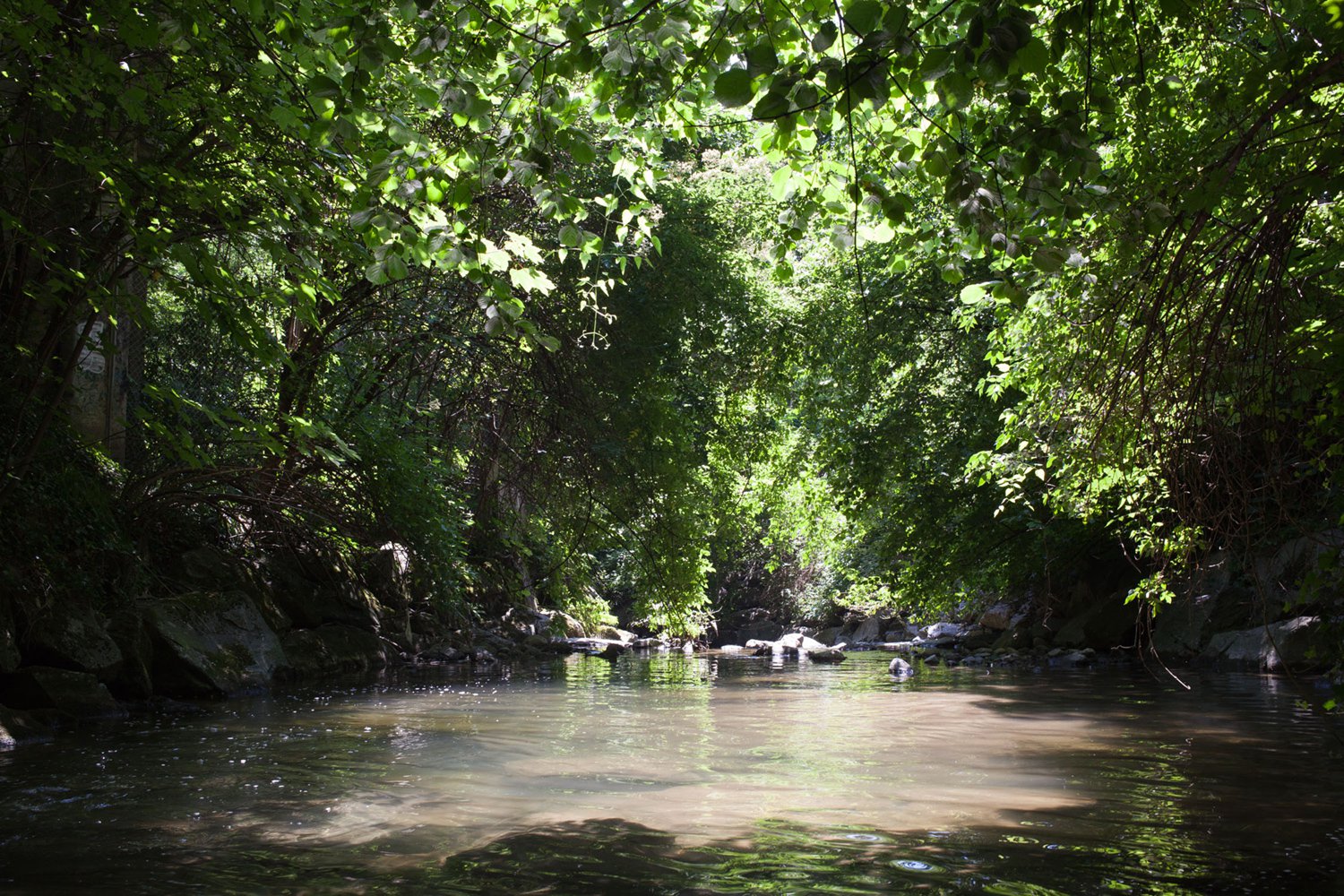
From soil to soil, our journey comes to an end. Turning into Avenue Guillemin on the left at the second roundabout, we arrive from the top at the park of the same name. The former countryside at La Peraudettaz comprised a mansion and outhouses that still stand. It actually welcomed a young hero of the Vaud independence movement at the end of the 18th century, Samson Reymondin, who was arrested and imprisoned several times. When Etienne Guillemin purchased the property in 1851, it included 23,000 m2 of land. His descendants gave the park to the City of Pully in 1944.
Like its counterpart in Valency, the park is frequently visited, and not only by humans. There are deer in the animal park as well as foxes, birds, hedgehogs and squirrels in the wooded bar, butterflies and insects in the prairie, earthworms, moles and millipedes in the subsoil. It is busy on every floor! The return of wildlife to the city is a reliable indicator of the good health of urban ecosystems. It is also a first step towards reconnecting the city with nature. But what place does fauna actually have in the city?
The Monument des petits animaux (29) — a structure based on the cast of molehill tunnels — glimpses into the parallel world that runs under our feet. In the embankment below, Le Cadran solaire de la taupe (30) reveals the schedule of that underground world, alien yet so familiar.
The walk is over. Going down the path to Avenue du Lavaux, you reach the Montillier bus stop on bus line No. 9. If you take it to return to the concrete world in the city centre, you might come across the Végibus (31), the figurative and mobile greenhouse for commuting plants that tirelessly travels the route of Lausanne Jardins 2019.
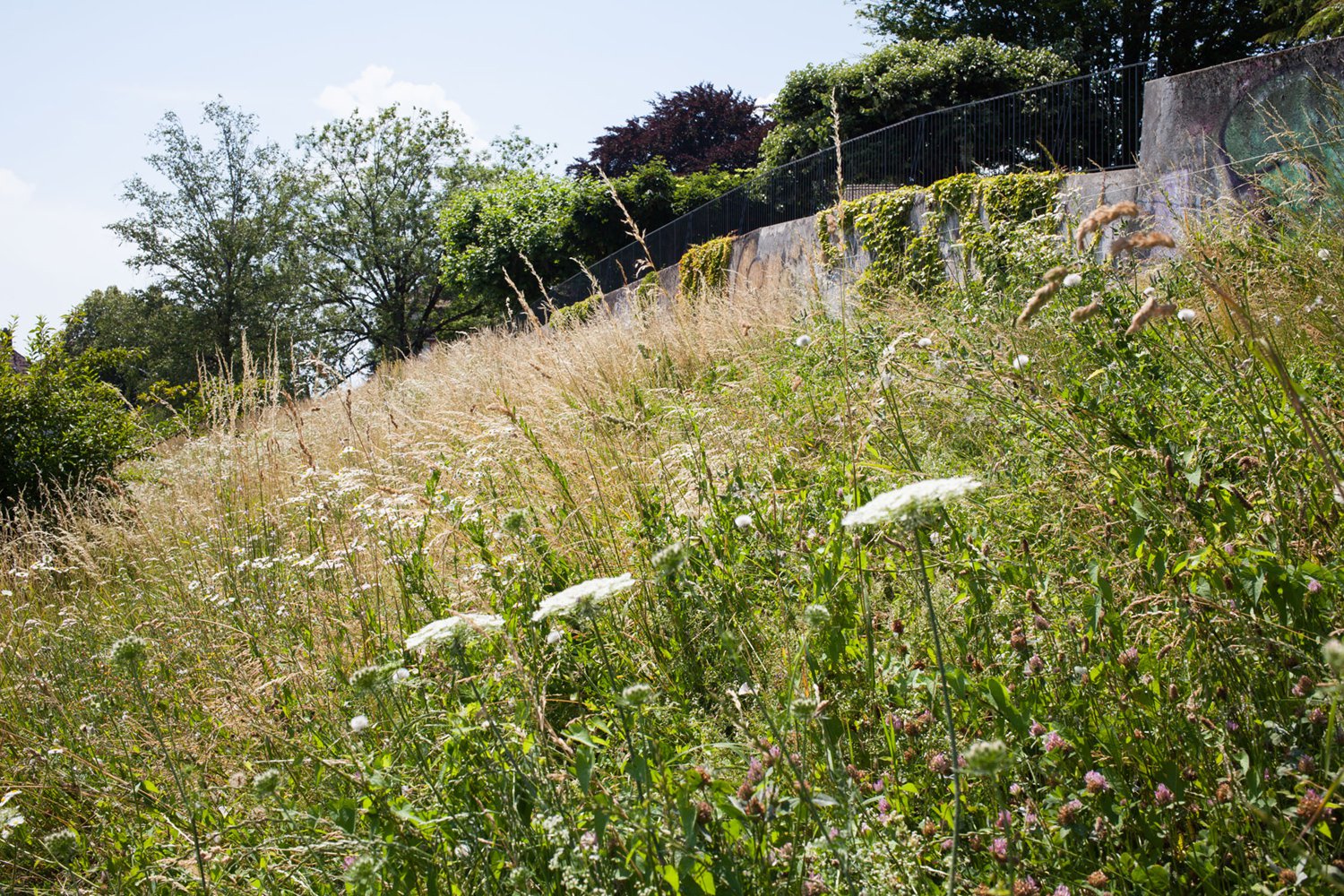
To accompany you along the walk, we have designed a roadbook – a guide (in French and in English) to explore the meanderings of the route and of course the 31 gardens in the 2019 festival. It is available at various points of sale.